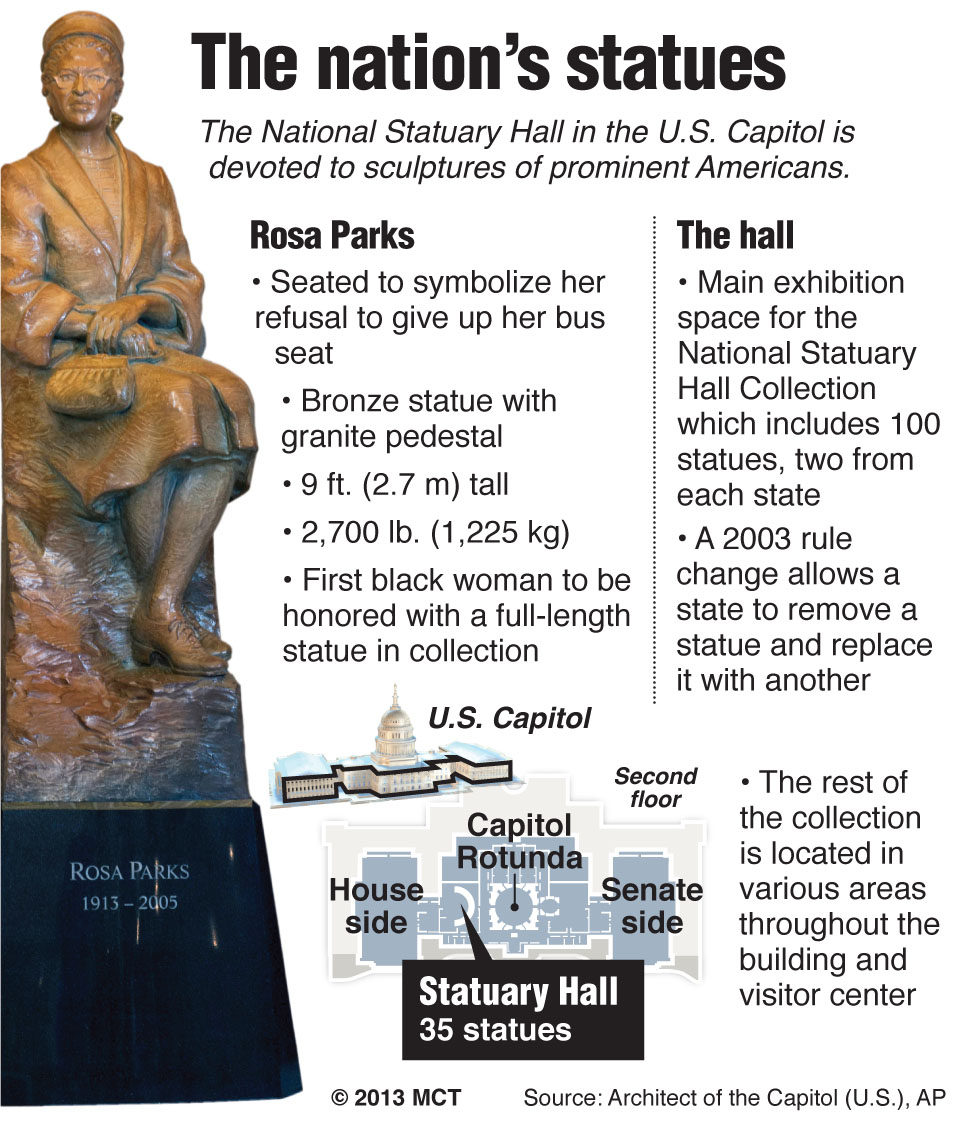

McClatchy Washington Bureau by Beena Raghavendran
By Beena Raghavendran
McClatchy Newspapers
WASHINGTON – She sits tall on a rock, eyes behind her famous circle-frame glasses, staring defiantly across the Capitol’s National Statuary Hall.
Civil rights activist Rosa Parks’ 9-foot bronze statue was unveiled in a ceremony Wednesday that included remarks from President Barack Obama and leaders of Congress, echoing words of her determination and legacy for the future.
“We make excuses for inaction,” Obama said, addressing the members of Congress and guests in the National Statuary Hall. “We say to ourselves, ‘It’s not my responsibility. There’s nothing I can do.’ Rosa Parks tells us there’s always something we can do.”
The president said that if it weren’t for civil rights leaders like Parks, he wouldn’t be in office today.
Her bronze likeness joins the Capitol Hill Art Collection after a law authorizing a commemorative statue of Parks’ legacy passed about a month after her death in 2005. Its unveiling is in conjunction with Parks’ 100th birthday earlier this month.
Joining the president was House Speaker John Boehner, R-Ohio; House Minority Leader Nancy Pelosi, D-Calif.; Senate Majority Leader Harry Reid, D-Nev.; Senate Minority Leader Mitch McConnell, R-Ky., and Rep. Jim Clyburn, D-S.C. Attending as well was Sheila Keys, Parks’ niece, and Elaine Steele, Parks’ longtime friend.
The statue represents a series of firsts: the first full statue of an African-American woman in the Capitol, and the first to be funded and commissioned by Congress since 1873. The timing of its placement also has a sense of historical symmetry.
It’s been 50 years since the pivotal 1963 March on Washington for civil rights and 150 years since the signing of the Emancipation Proclamation.
Boehner called Parks “a Lady Liberty for our times and all times,” saying the statue’s presence would impact members of Congress and visitors alike. Half a century ago, the placement of such a statue in the hall would have been impossible, he said.
Statue designers Eugene Daub and Rob Firmin of Daub & Firmin Sculpture Studios in Kensington, Calif., beat out more than 100 artists to design and build the piece. The two were selected as finalists in a competition held by the National Endowment for the Arts and were chosen by the Joint Committee on the Library of the U.S. Congress, which oversees the institution.
The partners designed the statue to reflect Parks’ determination, which is often softened in retellings of her story. Parks was a quiet woman, but she was also angry, said Firmin, who said that he researched her life thoroughly. That’s why the piece shows Parks turning away from racism and sitting on a rock, to represent the rock of the Civil Rights Movement that supported her.
Civil Rights leader Jesse Jackson said that Parks was a harsher activist than remembered, noting that her statue is gazing at the image of Confederacy leader Jefferson Davis across the hall.
Rep. Marcia Fudge, D-Ohio, chair of the Congressional Black Caucus, said that it was ironic that as they celebrated Parks, across the street the Supreme Court was hearing arguments in a case that challenges parts of the landmark Voting Rights Act of 1965.
“This is the very core of the cause to which Mrs. Parks devoted her life, and it is once again being questioned,” she said in a statement.
Ella McCall Haygan, regional director for Washington’s Rosa & Raymond Parks Institute for Self Development, knew Parks for 15 years. At the ceremony, she was wearing a hat and a pink sweatshirt plastered with photos of her and Parks. Haygan said that if Parks knew a statue of her was being unveiled, she would have humbly said that it was a nice gesture for the children and for the future.
Some members of Parks’ extended family from her mother’s side were originally denied a photo with the statue because of the long lines to view it. Lonnie McCauley of Detroit said that Parks was his grandfather’s sister, and he was upset that he couldn’t take a picture with his family member toward whom he felt such strong pride and ties.
“She lived for everyone,” he said.
Eventually, McCauley and his family were granted the photos. Afterward, he wrapped his arms around the bronze image of the civil rights icon, tears welling in his eyes.





